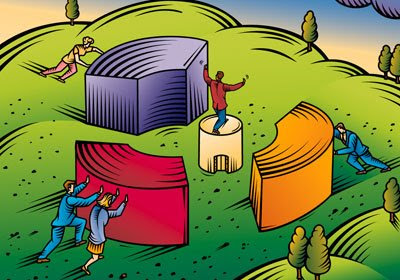
The great enabler
By Rod Newing
Published: June 29 2007 17:38 | Last updated: June 29 2007 17:38
No single technology can accommodate the complex processes and cultural ramifications of collaborative interactions. Successful collaboration results from using the right balance of face-to-face meetings and technology. Furthermore the technology, or combination of technologies, must be appropriate to each kind of interaction.
/// Conceptually, collaboration results from proper teamwork first.
But trying to work together remotely goes against our natural human instincts. "We are optimally evolved to talk at a range of about 5 feet in groups of no more than 90 people," says Ceri Roderick, a partner in Pearn Kandola, an occupational psychologist practice. "We respond to a rich stream of information and judge nuances, such as pronunciation or slight facial expressions." This enables us to assess people's motives, trustworthiness and reliability.
Take all that away and the bald words on the page can be over-interpreted or misunderstood. "As organisations become larger, more global and more dispersed," Mr Roderick warns, "we stretch the parameters and make life difficult for ourselves." The objective of technology is to replicate that rich stream of information when the communication is particularly important – for example, when building relationships and trust, solving problems or reviewing progress. This means operating in real-time and combining as many forms of communication as possible, such as images, voice and text. This process is called "unified communications" and it is made possible by the latest internet-based technologies. These combine to give much more information to provide more context to the exchange.
"Successful collaboration starts with the people," says Graham Oakes, a technology consultant. "They need to establish contact with each other and agree lines of communication, which is a lot easier to do face to face."
Mr Roderick recommends that people working in virtual teams should make time to meet occasionally. This allows them to understand more about the personal and cultural context of other individuals, which helps when they subsequently telephone or e-mail each other.
/// The team starts by building the Tangible Vision as a team. When they builds their Tangible Vision, they begin to learn something about their counterpart. ... For example, how does he/she think? How does he/she expresses their ideas? etc.
The need to get the balance right is shown by "Congested Lives", a research study of over 1,200 UK businesses employees carried out by YouGov for Polycom, a collaborative communications vendor. This showed that unnecessary face-to-face meetings cost businesses £17bn each year and 82 per cent of respondents who had travelled to meetings in the last year believed many of them were unnecessary.
If people want to build trust and relationships without the time and cost of travel, then video conferencing is the most effective tool. "The purpose of many video conferences is not necessarily to get things done but to build trust and contacts in the relationship," says Jeffrey Mann, vice-president of research at Gartner, the technology analyst. "Video and web conferencing are really relationship building, and not necessarily information passing or for agenda point processing, because people want to know who they are dealing with."
Growth in video conferencing has been forecast for many years, but so far it has failed to materialise. Professor Peter Cochrane, a futurologist and founder of ConceptLabs, puts its failure to date down to poor video and sound quality, no eye contact, no gaze awareness, no body language, small people images and no depth of field.
"Most of this can now be fixed," he says, "notably by Cisco Telepresence, which uses life-size high definition screens, audio straight out of the speaker's mouth from the right direction, eye contact and all in good quality. Hollywood discovered the value of emotions, for which good audio and video are the essential."
Asynchronous communication, where people interact over a period of time, is also a valuable tool. "If you are dealing with someone in another part of the world in another language, it gives them more time to think and react," says Mr Mann. "It is a real disadvantage if they have to think in real-time."
But there is a danger of sharing too much information. Microsoft's Enterprise IQ Survey 2007, in partnership with Henley Management College, found that an average workgroup of 25 people shares information 1,500 times a week and intensive information users share over 5,000 times a week. Even then, 22 per cent of documents are considered to be out of date.
"People are drowning in data and feel overwhelmed by information," says Jean-Anne Stewart, director of corporate programmes at Henley Management College. "There are issues of reliability and accuracy, which may be contributing to calling meetings to gather and share information."
/// When a Compass team leads with their Tangible Vision, they focus on the standards that are listed in their Tangible Vision. The Tangible Vision gives the Compass team a strategic overview of direction, connections and anticipation.
Although a wide range of corporate technologies exists to overcome some of the cultural issues surrounding collaborative working, a new range of consumer-based technologies is beginning to establish itself in the enterprise. Often referred to collectively as "Web 2.0", the technologies include social networks, wikis and blogs.
"The teenagers of today are using technology to communicate and collaborate like never before but the business world is struggling to figure out how to use them," says Neil Sutton, general manager for information technology services at BT.
When today's teenagers start their careers in the commercial world, it will have an impact on the way we communicate. They will prefer different ways of communicating, and this will affect collaboration within, and between businesses – but the business world is not ready for it."
Stewart Mader, wiki evangelist at Atlassian, a software systems company, points out that the generation now entering the workforce are experts in social media and are already collaborating with each other. One of the reasons for the success of Web 2.0 tools is that they blur the line between pure business productivity and the building of an emotional connection, a sense of ownership and involvement, which allows people to interact directly with other people to build their knowledge.
"They approach knowledge as the product of that organic, non-linear human connection and collaboration," he says. "Imagine unleashing that potential in the professional world."
People's individual web profiles are the foundation of social networks, allowing them to connect to each other and to information. These profiles add the necessary "context" to the collaboration.
IBM has been using the same approach for eight years with its 475,000 "Blue Pages" employee and partner profiles. These include an individual's experience, skills, projects they have worked on, their patents and publications, the content they have created, the activities they are involved in and the communities in which they participate.
"They are accessed 6m times a day to find more about the people you know and to find the people you don't know," says Jeff Schick, worldwide vice-president for social software at the company. "You really get a better understanding of who the individual is, what they do and what they know."
The CIX electronic conferencing system has been using the personal information of its users to make connections since before the internet became pervasive. "They are essential for building a mental picture of your remote colleagues," says Graham Davies, the company's managing director. "It helps us to predict how a person will interpret and react to our ideas and suggestions, in the same way their facial emotions and body language would in a face-to-face situation."
Clearly, technology can help to address a number of cultural problems associated with collaboration – but not if they are used exclusively. As Prof Cochrane concludes: "Collaboration still works best if it is supported by human contact that cements trust and familiarity on a regular basis."
Copyright The Financial Times Limited 2008
http://www.ft.com/cms/s/2#
When the Compass team collaboratively builds and connects with their Tangible Vision, they become familiarized with the priorities and the approaches to completing their goal and the circumstances that can occur. ... They know their role and responsibilities in certain situations while learning something about each other. ... The members of the team collaboratively trust each other and know that everyone is accountable. The team is always decisive in their actions as a team and continually trusts their Tangible Vision.
"One who excels at warfare will await events in the situation without making any movements. When he sees he can be victorious he will arise; if he see he cannot be victorious he will desist. Thus it is said he doesn’t have any fear, he doesn’t vacillate. Of many harms that can beset any army, vacillations is the greatest. Of disasters that can befall an army, none surpasses doubt.”
– Six Secret Teachings, 26
By connecting with their Tangible Vision, a Compass team always know what are their priorities and the approaches regardless of the circumstances. There is no doubt in the mind of the Compass Implementors.
If you are interested in knowing more about how Compass AE works, please contact us at service [at] collaboration360 [dot] com. We have a white paper ready for your reading.
Copyright © 2008 Collaboration360 Consultants (and Collaboration360.com) All rights reserved. Copying, posting and reproduction in any form (without prior consent) is an infringement of copyright
#



No comments:
Post a Comment